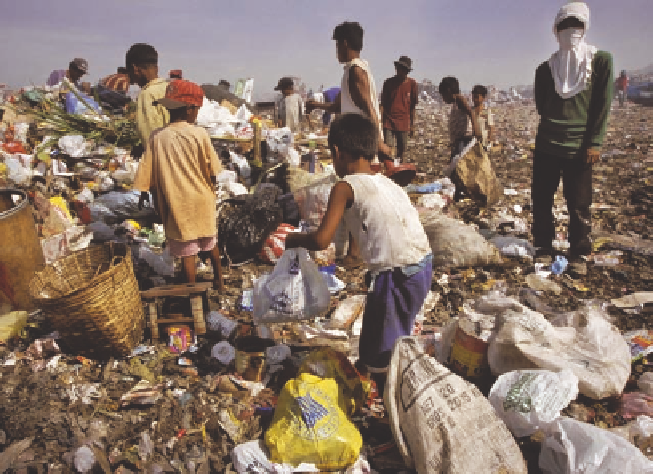Environmental Engineering Reference
In-Depth Information
beverage bottles stimulates local economies by creat-
ing local jobs related to their collection and refilling.
Studies by Coca-Cola and PepsiCo of Canada show
that their soft drinks in 0.5-liter (16-ounce) bottles cost
one-third less in refillable bottles than in throwaway
bottles.
But big companies make more money by produc-
ing and shipping throwaway beverage and food con-
tainers at centralized facilities. This shift has put many
small local bottling companies, breweries, and canner-
ies out of business and eliminated their economic in-
puts into local communities.
Denmark and Canada's Prince Edward Island
have led the way by banning all beverage containers
that cannot be reused. To encourage use of refillable
glass bottles, Ecuador levies a refundable beverage
container deposit fee that amounts to 50% of the cost
of the drink. In Finland, 95% of the soft-drink, beer,
wine, and spirits containers are refillable; in Germany,
about three-fourths are refillable.
Figure 17-6
Global outlook:
these children in an open dump near
Manila in the Philippines are searching for materials to sell for reuse or
recycling. Many of these rubbish pickers live in or near such dumps.
x
H
OW
W
OULD
Y
OU
V
OTE
?
Do you support banning all
beverage containers that cannot be reused, as Denmark
has done? Cast your vote online at http://biology.brookscole
.com/miller11.
Another example of reuse involves
tool libraries
(such as those in Berkeley, California, and Takoma
Park, Maryland) where people can check out a variety
of power and hand tools. Figure 17-7 lists several ways
for you to reuse some of the items you buy.
Solutions: Other Ways to Reuse Things
We can employ reusable shopping bags, food
containers, and shipping pallets, and borrow tools
from tool libraries.
Cloth bags can be used to carry groceries and other
items instead of paper or plastic bags. Both paper and
plastic bags are environmentally harmful, and the
question of which is more damaging has no clear-cut
answer. To encourage people to bring reusable bags,
stores in the Netherlands and Ireland charge for shop-
ping bags. In response, the use of plastic shopping
bags has dropped by 90-95% in both countries. In
2004, supermarkets in Shanghai, China's largest city,
began charging shoppers for plastic bags in an attempt
to reduce waste.
What Can You Do?
Reuse
• Buy beverages in refillable glass containers instead
of cans or throwaway bottles.
• Use reusable plastic or metal lunchboxes.
• Carry sandwiches and store food in the refrigerator
in reusable containers instead of wrapping them in
aluminum foil or plastic wrap.
x
H
OW
W
OULD
Y
OU
V
OTE
?
Should consumers have to pay
for plastic or paper bags at grocery and other stores? Cast
your vote online at http://biology.brookscole.com/miller11.
• Use rechargeable batteries and recycle them when
their useful life is over.
• Carry groceries and other items in a reusable
basket, a canvas or string bag, or a small cart.
Other examples of reusable items include metal or
plastic lunchboxes and plastic containers for storing
lunchbox items and refrigerator leftovers, instead of
using throwaway plastic wrap and aluminum foil.
Manufacturers can use shipping pallets made of
recycled plastic waste instead of throwaway wood
pallets. In 1991, Toyota shifted entirely to reusable
shipping containers. A similar move by Xerox has
saved the company more than $3 million per year.
• Use reusable sponges and washable cloth napkins,
dishtowels, and handkerchiefs instead of
throwaway paper ones.
Figure 17-7
Individuals matter:
ways to reuse some of the
items you buy.
Critical thinking: which three of these actions do
you believe are the most important? Which things in this list do
you do or plan to do?








